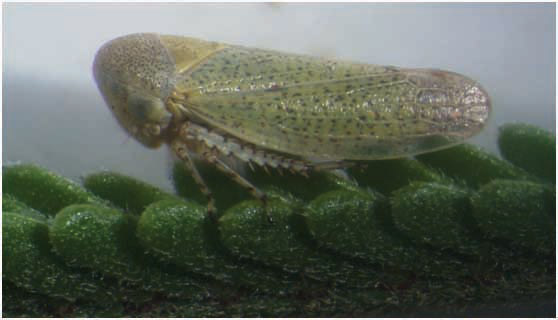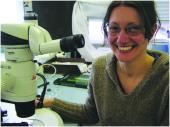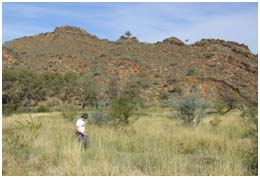| Publication Type | Journal Article [4] | |
| Year of Publication | 2010 | |
| Authors | Castalanelli, M.A. [5]; Severtson, D.L. [6]; Brumley, C.J. [7]; Szito, A. [8] | |
| Journal Title | Journal of Asia-Pacific Entomology | |
| Volume | 13 | |
| Issue | 3 | |
| Pages | 243-248 |


| Publication Type | Journal Article [4] | |
| Year of Publication | 2010 | |
| Authors | Castalanelli, M.A. [5]; Severtson, D.L. [6]; Brumley, C.J. [7]; Szito, A. [8] | |
| Journal Title | Journal of Asia-Pacific Entomology | |
| Volume | 13 | |
| Issue | 3 | |
| Pages | 243-248 |
This project will help increase understanding of the taxonomy and systematics of a subfamily of leafhoppers in Australia, known as Macropsinae (Hemiptera: Cicadellidae). The study aims to clarify which genera are represented amongst the Australian fauna and investigate whether any Australian species belong to the genera Macropsis and/ or Oncopsis. These two genera contain plant disease vector species overseas. This project will also investigate the relationships between Australian macropsines and those pest groups from overseas. Through a sound understanding of the taxonomy and systematics of the existing Australian macropsine fauna, this study will contribute to Australia’s biosecurity and improve diagnostic capability to identify potential incursions of emergency plant pests.
Leafhoppers are phytophagous insects which can cause plant damage through feeding but are also vectors of serious plant diseases in agricultural and horticultural crops. Leafhoppers are considered major pests of economic significance. For this reason some groups of leafhoppers are well studied both taxonomically and biologically. However, some groups of leafhoppers, such as macropsines, have been overlooked and have received little taxonomic attention, particularly in Australia. In part, this neglect may be due to the taxonomic complexity of this group.
At least four macropsine species are known to transmit plant diseases overseas. This includes species of Macropsis which transmit a phytoplasma known as rubus stunt, (affecting blackberries, raspberries and other berry crops) in Europe. At least one further Macropsis species is known to be a vector of peach yellows phytoplasma which affects Prunus crops (peach, nectarine, almonds and apricots) in the USA. However, there are no records that these diseases or their vectors occur in Australia.
A recent study also found that one species of Oncopsis is capable of transmitting a phytoplasma (related to grapevine yellows) from alder trees to grapevines.
The above study stimulated interest in the taxonomy of the Australian macropsine fauna. Of particular interest, is the relationship between Australian macropsine species and those of the plant disease vector species from overseas.
Along with increased international trade, new leafhopper pests and plant pathogens may be introduced to Australia. It is important to have a basic taxonomic understanding of the Australian macropsine fauna to more readily distinguish any introduced exotic species.
improve understanding of the taxonomy and systematics of the Australian macropsine leafhoppers. This research will clarify which macropsine genera occur in Australia and provide easier identification with dichotomous keys, images and descriptions to be published in relevant scientific journals
provide insight into the relationship between Australian and overseas macropsine genera, particularly those with plant disease vectors such as Macropsis and Oncopsis
generate new DNA sequence data for those macropsine species tested. This data will be made available on Genbank and primers and techniques used for testing to be published
assist with expediting issues surrounding market access, (particularly the berry and stone fruit industry) by providing a more complete catalogue of leafhopper genera and species currently present in Australia, and
improve diagnostic capability through keys, descriptions and illustrations this study will allow easier diagnosis (using both morphological and molecular techniques) of macropsine species/ specimens intercepted by diagnosticians, scientific researchers or by growers.
The end-users include Plant Health Australia, the Department of Agriculture, Fisheries and Forestry (including the Australian Quarantine and Inspection Service), state government departments, such as primary industries as well as state regulatory bodies. Keys and diagnostic descriptions will also be useful for identification of leafhoppers by diagnosticians, museum staff or those working in insect reference collections and other entomological researchers such as those involved with biological surveys.

Linda Semeraro collecting insects with sweep net,
DPI Knoxfield. Photo taken by: Isabel Valenzuela

Macropsine species (undetermined)
– belongs to possible new genus –
collected by sweeping Acacia mearnsii
DPI Knoxfield, Victoria. Photo taken by: Linda Semeraro.

This project discovered whether Australian smuts represent a monophyletic group and what ecological factors shaped the diversity of smut fungi in Australia. It also researched whether the evolution of host plants drove the evolution of the smut fungi. It also looked at whether there are molecular loci that allow for nano-scale diagnostic techniques to distinguish smut species and if there are any morphological synapomorphies within smut fungi that will allow them to be split into clear taxonomic groups.
The biodiversity of smut fungi is immense. Vast numbers of cryptic and intriguing smuts occur naturally in undisturbed ecosystems. Smuts occupy many ecological niches and a close relative, the dandruff fungus Malasezzia, even infects animals. Grasses including crops such as wheat, sugarcane, rice, maize and sorghum are all susceptible to smut infection. Diseased plants become infertile as their flowers or seeds are substituted with masses of black, powdery spores. For some cereal grains, entire harvests can become near worthless with the presence of smut spores. It has been estimated that the introduction of wheat smut (Karnal bunt caused by Tilletia indica) to Australia would cause a $A.1.3 billion sway in the economy through a loss of wheat exports, new import costs and job redundancies.
Over 1,500 smut species are known and we are on the verge of understanding the evolution and resolving the taxonomic issues within the group. Australian smut fungi have been comprehensively qualified and their identification has been revolutionized by an interactive, computerized key (Lucid). However, there is some turmoil within the classification of smut fungi as some genera/groups (in particular the Ustilago/Sporisorium/Macalpinomyces complex) overlap causing confusion with species placement. This is problematic as people refer to the same organism by different names. Phylogenetic analysis of morphology, biogeography and molecular loci may indicate how smut fungi evolved and reveal a more accurate classification system.
The diagnostic tools produced for smut fungi will be a model for the creation and application of nanobead diagnostics for other organisms.
AQIS and other quarantine organisations, mycologists, systematists.


Links:
[1] http://legacy.crcplantbiosecurity.com.au/publications/npb1841
[2] http://legacy.crcplantbiosecurity.com.au/education-and-training
[3] http://legacy.crcplantbiosecurity.com.au/education-and-training/project/crc60046-khapra-beetle-phd
[4] http://legacy.crcplantbiosecurity.com.au/publications/research/type/102
[5] http://legacy.crcplantbiosecurity.com.au/publications/research/author/Castalanelli
[6] http://legacy.crcplantbiosecurity.com.au/publications/research/author/Severtson
[7] http://legacy.crcplantbiosecurity.com.au/publications/research/author/Brumley
[8] http://legacy.crcplantbiosecurity.com.au/publications/research/author/Szito
[9] mailto:Linda.Semeraro@dpi.vic.gov.au
[10] http://legacy.crcplantbiosecurity.com.au/bio/semerarol
[11] mailto:alistair.mctaggart@deedi.qld.gov.au
[12] http://legacy.crcplantbiosecurity.com.au/content/mctaggart